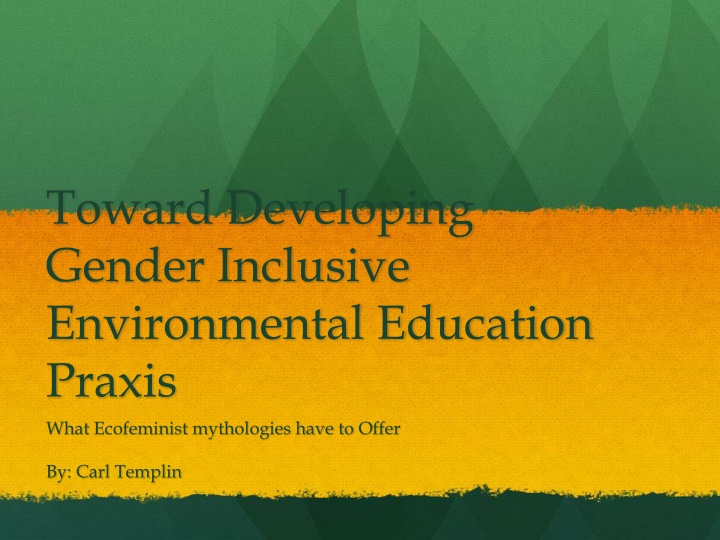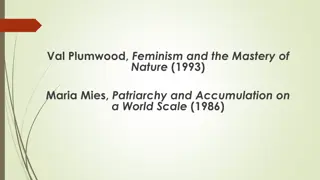
Ecofeminist Mythologies in Gender-Inclusive Environmental Education Praxis
Delve into the ecofeminist perspective on the interconnected subjugation of both nature and women, exploring different mythologies and their potential contributions to educational praxis for gender equality and environmental sustainability.
Download Presentation

Please find below an Image/Link to download the presentation.
The content on the website is provided AS IS for your information and personal use only. It may not be sold, licensed, or shared on other websites without obtaining consent from the author. If you encounter any issues during the download, it is possible that the publisher has removed the file from their server.
You are allowed to download the files provided on this website for personal or commercial use, subject to the condition that they are used lawfully. All files are the property of their respective owners.
The content on the website is provided AS IS for your information and personal use only. It may not be sold, licensed, or shared on other websites without obtaining consent from the author.
E N D
Presentation Transcript
Toward Developing Gender Inclusive Environmental Education Praxis What Ecofeminist mythologies have to Offer By: Carl Templin
Self-Introduction Bachelor s in Philosophy Master s in Educational Foundations 2 years teaching English in China Ph. D. Student in Educational Foundations (focusing on Sex Education and Gender Issues) and working on a Certificate in Women s and Gender Studies.
Introduction: Basic Ecofeminist Claims The subjugation of the earth by human beings parallels the subjugation of women by men. The establishment of patriarchy has lead to both of the above conditions. Ecofeminism, therefore, opposes hegemonic patriarchal thinking (Tong; Warren as cited in Tong 2009).
Introduction: My Claims Each sub-tradition of ecofeminism favors a particular mythologized explanation of people s/women s connection to nature. Not every aspect of each of these mythologies represent a desirable tool for serving educational goals aimed at promoting both gender equality and environmental friendliness.
Introduction: My Purposes To outline each of the competing ecofeminist mythologies To analyze these mythologies in order to discern which aspects of which mythologies have the potential to make positive contributions to educational praxis aimed at gender equality and the environment
Background The kind of relationship that men have with the environment tends to differ from the kind of relationship that women have with the environment. Even in adolescence, girls show a greater degree of concern for the environment than do boys (Hampel, Boldero, Holdsworth 1996). As of the year 2000, women reported greater participation in proenvironmental behavior/activism (Zelezny, Chua, Aldrich 2000, p.445) For a variety of ideological and economic reasons women are disproportionately negatively affected by environmental degradation (Gaard & Gruen 2003; Agarwal 1992). For these reasons women are often defined and portrayed as being closer to nature than men.
Ecofeminist Sub-traditions According to Tong (2009) there are four main sub- traditions of ecofeminism each of which addresses the woman-nature connection differently. The woman-nature connection ought to be severed . The woman-nature connection ought to be reaffirmed . The woman-nature connection should be conceptualized and approached spiritually . The woman-nature connection should be transformed into something with a more positive meaning. Each of these sub-traditions builds on a supporting mythology.
Elements of these Mythologies Sever The Connection Humanity is superior to nature and, therefore, to identify women with nature is to degrade them. The biological functioning of the female body does not justify naturalizing the confinement of women to inferior social positions. Reaffirm the Connection The dominance of (male) culture over women and nature is contingent and was not always in place. Women naturally have some special (though not necessarily biological) connection to the environment that men do not and cannot have. Men are primarily responsible for the oppression of women and nature and, therefore, either hierarchical (male) thinking must be abolished or women must reposition themselves and nature to be equal with or superior to men.
Elements of the Spiritual Mythology Spirituality The idea of God possessing male traits is incompatible with a lifestyle that is friendly to both women and the environment. It is a basic duty of all people to spend their lives in pursuit of positive relationships with each other and a healthy environment. Transformative The woman-nature connection is socially constructed and can, therefore, be altered by changing social practices. Both men and women are affected by these social constructions and, therefore, both bear some responsibility in changing them. Dichotomous thinking regarding the environment is harmful to women and nature and therefore should be greatly limited or eradicated.
Analysis of Each Sub- tradition s Mythology Sever the Connection While stressing that men and women are on the same side is valuable, the fact that this sub-tradition is far more concerned with the status of women than the state of the environment means that its usefulness as a foundation for environmental educational praxis is limited. Reaffirm the Connection While encouraging people to see themselves as part of nature, thus, providing incentive to care for nature is valuable, this sub-tradition s negative stance toward men can lead to men disengaging form the environmental project and lead to a sort of reverse chauvinism whereby women simply dismiss the thoughts and feelings of men.
Analysis of Each Sub- tradition s Mythology Spirituality Again, focusing on people as part of nature is useful, however, the main drawback to this sub-tradition is its spiritual or religious implications that limit its possible use as a basis for praxis within institutions endorsement of this standpoint violates the establishment clause of the US Constitution in public schools and is not likely it gain support in private schools, most of which are invested in more traditional religious concepts. Transformative This sub-tradition is extremely pragmatic, avoids demonizing men, and is spiritually/religiously neutral, however, it could be construed as bordering on though control and, therefore, rests on ethically questionable grounds positing the elimination of dichotomous thinking on the grounds that it has the potential to harm women and the environment is analogous to positing that certain people determined to be likely to be criminals ought to be punished before any crime has been committed.
Are Women More Environmentally Ethical? Evidence does suggest that women are more environmentally ethical than men. In addition to the findings of Hampel, Boldero, Holdsworth (1996) and Zelezny, Chua, Aldrich (2000) stated earlier, Norgaard and York (2005) found that the implementation of environmentally friendly policies correlates positively with the inclusion of women in government.
Is the Woman-Nature Connection Natural? This is important to answer because if the connection is natural, and women are, therefore, naturally more environmentally ethical, then education can have little if any effect. However, if women are more environmentally ethical because they have been socialized to be so then education can have a greater effect. Of the four ecofeminist sub-traditions discussed three build on the premise that women are naturally connected to the environment (the transformative sub-tradition being the only one that does not).
Is the Woman-Nature Connection Natural? Research suggests that the woman-nature connection is not natural. Hunter, Hatch, and Johnson (2004) compared the environmentally-oriented behavior of men and women across 22 nations and found (1) that in the private sphere across gender differences do not exist for all incorporated nations (p. 685), (2), that GNI is a far better predictor of women s private sphere environmentally- oriented behavior than gender difference, and (3) that men and women engage in roughly the same amount of public sphere environmentally-oriented behavior. Somma and Tolleson-Rineheart (1997) tested whether environmental measures alone can classify respondents by sex (p. 159) and found that these attitudes can do no such thing (p. 159).
Conclusions While no single sub-tradition of ecofeminism has an underlying mythology that is capable of also serving a basis for reasonable educational praxis elements of each sub-tradition s mythology can be combined to create a praxis that promotes the interests of both women and the environment. Such a praxis should include: A focus on unity between men and women A focus on unity between humans and the environment A focus on critical reflection and on possible alteration of social constructs that harm both women and the environment (but not broad-scale thought processes that have only the potential to do so) Such praxis should not proceed under the assumption that women are naturally more connected to nature or naturally more environmentally ethical because such claims are neither helpful as educational tools nor supported by empirical research.
References Agarwal, B. (1992). The gender and environment debate: Lessons from India. Feminist Studies, 18(1), 119-158. Gaard, G., & Gruen, L. (2003). Ecofeminism: Toward global justice and planetary health. Pp. 276-293, In A. Light, & H. Rolston III, Environmental Ethics: An anthology. Malden, MA: Blackwell Pub. Hampel, B., Boldero, J., & Holdsworth, R. (1996). Gender patterns in environmental consciousness among adolescents. ANZJS, 32(1), 58-71. Hunter, L. M., Hatch, A., & Johnson, A. (2004). Cross-national gender variation in environmental behaviors. Social Science Quarterly, 85(3), 677-694. Norgaard, K., & York, R. (2005). Gender equality and state environmentalism. Gender & Society, 19(4), 506-522. Somma, M., & Tolleson-Rinehart, S. (1997). Tracking the elusive green women: Sex, environmentalism, and feminism in the United States and Europe. Political Research Quarterly, 50(1), 153-169. Tong, R. (2009). Feminist Thought, 3rdedition. Charlotte, NC: Westview Press. Zelezny, L. C., Chua, P-P., & Aldrich, C. (2000). Elaborating on gender differences in environmentalism. Journal of Social Issues, 56(3), 443-457.






















